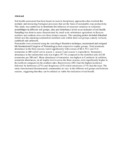Seasonal variations of nematode assemblages and diversity in vertisols, cambisols and arenosols soil groups in Kenya

View/
Date
2014Author
Thuo, A K
Kimenju, J W
Kariuki, G M
Karuku, G N
Wendot, P K
Melakeberhan, H
Language
enMetadata
Show full item recordAbstract
Soil health assessment has been based on narrow
disciplinary approaches that overlook the multiple
and interacting biological processes that are the
basis of sustainable crop productivity. This study
was carried out to determine the
influence of
seasonal variations in nematode assemblages in
different soil groups, sites and disturbance levels
as an indicator of soil health.
Sampling was done
in areas characterized by small scale subsistence
agriculture in Kenyan northern and southern
sites over three distinct seasons. The sampling
points included disturbed (tilled) and the adjoining
undisturbed (untilled) soils within three soil groups,
namely vertisols, cambisols and arenosols.
Nematodes were extracted using the centrifugal-
floatation technique, enumerated and assigned
136
6th International Congress of Nematology
to their respective trophic groups. Total nematode
abundance in the three seasons varied significantly
with a mean of 68.4, 93.1 and 51.6 nematodes in
200 cm
3
of soil in season 1, season 2 and season
3, respectively. Nematodes abundance in the
undisturbed soils was higher (97.74) compared
to the disturbed soils (62.08 nematodes per 200
cm
3
. Mean abundance of nematodes was highest
in Ccmbisols. In addition, nematode abundances,
in all trophic levels across the three seasons, were
significantly higher in the northern compared to
the southern sites. Bacterivores (28%) had the
highest incidence followed by herbivores (27%)
and fungivores (21%) while omnivores (11%) had
the least. The study demonstrated that nematode
communities do vary in the different soil groups
and between seasons, suggesting that they can
be utilized as viable bio-indicators of soil health.
Citation
Thuo, A. K., Kimenju, J. W., Kariuki, G. M., Karuku, G. N., Wendot, P. K., & Melakeberhan, H. (2014, June). SEASONAL VARIATIONS OF NEMATODE ASSEMBLAGES AND DIVERSITY IN VERTISOLS, CAMBISOLS AND ARENOSOLS SOIL GROUPS IN KENYA. In JOURNAL OF NEMATOLOGY (Vol. 46, No. 2, pp. 247-247). PO BOX 311, MARCELINE, MO 64658 USA: SOC NEMATOLOGISTS.Publisher
University of Nairobi
